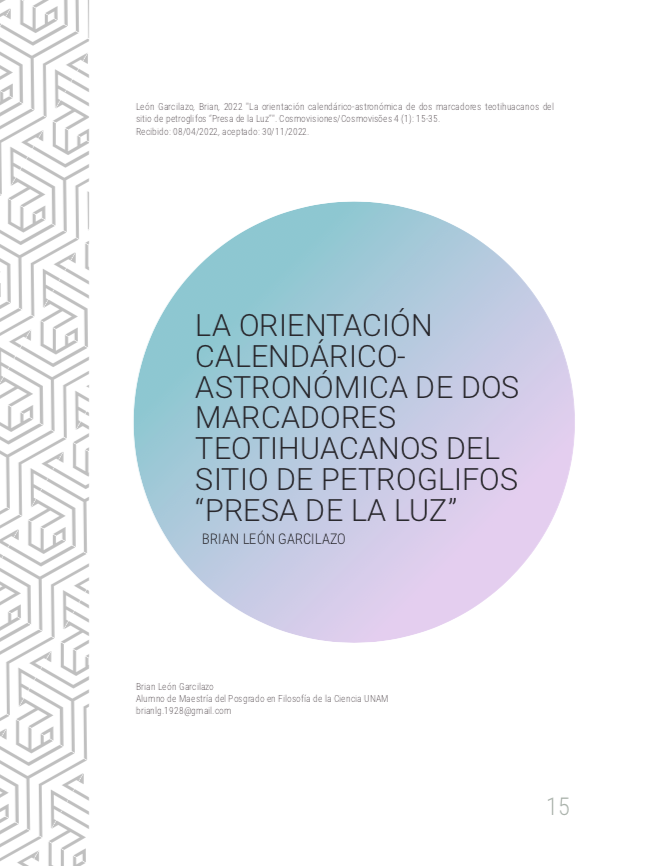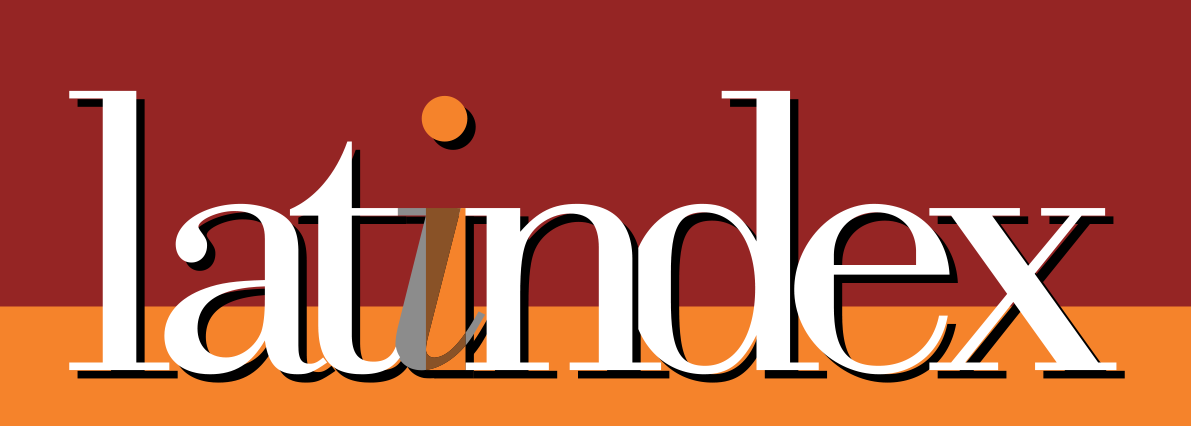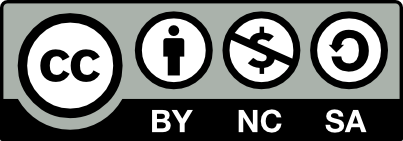La orientación calendárico-astronómica de dos marcadores teotihuacanos del sitio de petroglifos “Presa de la Luz”
Keywords:
Mesoamerica, Altos de Jalisco, Pecked Crosses, Archaeoastronomy, CalendarAbstract
More than 600 petroglyphs and at least 13 pecked crosses have been found in the surroundings of the La Luz dam (by its name in Spanish) (Esparza y Rodríguez, 2018). However, our work will be focused on the analysis of the PLU 3 and PLU 4 pecked crosses which are in the dam’s north shore. Both pecked crosses consist in two concentric semicircles divided by four arms. The astronomical orientation analysis shows a solar alignment for the east arm (30th March and 12th September) and for the west arm (5th March and 7th October). As we can see, these last dates are very close to the 73 family of Mesoamerican orientations. Meanwhile, the PLU 4’s west arm points out to the spring and summer equinox Sun’s rise and the west arm shows a solar alignment at the 27th March and 14th September’s sunset. This last pair of solar alignments are related to a lunar count of six months.
Downloads
References
Anuario del Observatorio Astronómico Nacional. (2021). Instituto de Astronomía. México: UNAM.
Aveni, Anthony F. Hartung, H. y Buckingham B. (1978) The Pecked Cross Symbol in Ancient Mesoamerica. Science 202 (4365), 267- 279.
Aveni, Anthony F. Hartung, H. y Charles K. (1982) Alta Vista (Chalchihuites), Astronomical Implications of a Mesoamerican Ceremonial Outpost at the Tropic of Cancer. American Antiquity 47 (2), 316-335.
Aveni, Anthony F. y Hartung, H. (1985) Las cruces punteadas en Mesoamerica: Versión actualizada. Cuadernos de Arquitectura Mesoamericana (4), 3-13.
Aveni, Anthony F. (2005) Observations on the pecked designs and other figures carved on the South Platform of the Pyramid of the Sun at Teotihuacan. Journal of the History of Astronomy 36 (1), 31-47.
Chavero, A. (1884) Historia Antigua y de la Conquista. En Riva Palacio, Vicente (ed.) México A través de los Siglos. México: Ballescá y Compañía Editores. 731–140.
Fauguère-Kalfon, B. (1997) Las representaciones rupestres del Centro- Norte de Michoacán. México: Centro Francés de Estudios Mexicanos y Centroamericanos (CEMCA).
Galindo Trejo, J. Wallrath Boller, M. y Rangel Ruíz, A. (1991) Marcadores punteados como manifestación de la ideología teotihuacana respecto al cielo: El caso de Xihuingo.En Ruíz Gallut. M. E. (ed.) Memorias de la Primera Mesa Redonda de Teotihuacán. México: UNAM. 255-271.
Galindo Trejo, J. (2003) La astronomía prehispánica en México. En Galindo Trejo, J. Torres García, M. A. de la Luz Moreno, M. Ruíz de Esparza, J. Moreno Corral, M. A. y Torres de Peimbert, S. (ed.) Lajas Celestes: astronomía e historia en Chapultepec. México: CONACULTA, INAH, Patronato del Museo Nacional de Historia, UNAM. 15-87.
Galindo Trejo, J. (2011) Orientación calendárico-astronómica en el Preclásico: el caso de La Venta. En Flores Gutiérrez, D. Rosado Solís, M. y Franco López, J. (coord.) El Legado Astronómico. México: IA-UNAM. 233- 241.
Galindo Trejo, J. (2020) Alineación calendárico-astronómica vinculada a rituales de fuego en la ciudad maya de Ichmac. Cosmovisiones/ Cosmovisões 1 (2), 15-34.
González Torres, Y. (1972) Algunos aspectos del culto a la Luna en el México antiguo. Estudios de Cultura Náhuatl 10, 113-127.
Esparza López, R. y Rodríguez F. (2015) Los Pecked Cross del Sitio Presa de la Luz, Municipio de Jesús María, Jalisco. Un acercamiento a su posible interpretación. En Ramírez, G. Mendiola, F. Breen W. Viramontes C. (ed.) Arte Rupestre de México para el Mundo. Avances y Nuevos Enfoques de Investigación, Conservación y Difusión de la Herencia Rupestre Mexicana. Tamaulipas: Gobierno del Estado de Tamaulipas, INAH- Tamaulipas. 195-207.
Esparza López, R. y Rodríguez F. (2018) El Santuario Rupestre de los Altos de Jalisco. México: El Colegio de Michoacán.
Ingram, L. Edward. (1911) Geodetic Surveyingand the adjustment of observation (method of least squares). McGraw-Hill. 370-371.
Iwaniszewski, S. (1992) Mesoamerican cross circles and seasonal cycles. En Iwaniszewski, S. (ed.) Readings in Archaeoastronomy. Warsaw: State Archaeological Museum, Warsaw and Department of Historical Anthropology, Institute of Archaeology and University Warsaw. 98-104.
Iwaniszewski, S. (1991) La arqueología y la astronomía en Teotihuacan. En Broda, J. Iwaniszewski, S. y Maupomé, L. (ed.) Arqueoastronomía y Entoastronomía en Mesoamérica. México: UNAM, Instituto de Investigaciones Históricas. 269-291.
Iwaniszewski, S. (2015) Pecked Cross-Circles. En Ruggles, Clive L. N.(ed.) Handbook of Archaeoastronomy and Ethnoastronomy. UK: Springer. 737-742.
Iwaniszewski, S. (2018) Tres marcadores calendáricos en Cocotitlán, Edo. de México. Estudios Latinoamericanos (38), 25-45.
Iwaniszewski, S. (2020) La Pirámide de los Nichos en El Tajín: Calendario, ritual, simbolismo mítico. Cosmovisiones/Cosmovisões 1 (1), 106-120.
López Austin, Alfredo. (2014) El tiempo en Mesoamérica. En Carrillo C. (coord.) Antologías de la revista Ciencias: Calendario, astronomía y cosmovisión: El conocimiento mesoamericano I. Vol. 3. Facultad de Ciencias-UNAM, Siglo XXI Editores. 19-31.
Montero García, I. A. (2013) Apuntes sobre Altavista en Chalchihuites, Zacatecas. Cuicuilco (56), 95-126.
Morante López, R. B. (1997) ¿El ábaco teotihuacano?. Estudios de Cultura Náhuatl 27, 419-433.
Rétiz García, M. A. y Cárdenas García, E. (2017) Las cruces punteadas en la cuenca Lerma-Chapala: Evidencias de interacción y tradiciones regionales. En Cárdenas García, E. (ed.) Migraciones e Interacciones en el Septentrión Mesoamericano. México: El Colegio de Michoacán. 105-117.
Séjourné, L. (1994) Teotihuacán capital de los toltecas. México: Siglo XXI Editores.
Šprajc, Iván. (2000) Astronomical Alignments at Teotihuacan, Mexico. Latin American Antiquity. Society for American Archaeology11 (4), 403- 415.
Šprajc, Iván, y Sánchez Nava Pedro F. (2012) Orientaciones astronómicas en la arquitectura maya de las tierras bajas: nuevos datos e interpretaciones. En B. Arroyo, L. Paiz y H. Mejía (eds.) Memorias del XXV Simposio de Investigaciones Arqueológicas en Guatemala. Ministerio de Cultura y Deportes, Instituto de Antropología e Historia, Asociación Tikal. 977-996.
Šprajc, Ivan, y Sánchez Nava Pedro F. (2015) Orientaciones astronómicas en la arquitectura de Mesoamérica: Oaxaca y el Golfo de México. Prostor, Kraj Čas 8. Založba ZRC, Ljubljana.
Velásquez, García E. (2016) Códice de Dresde. Edición Facsimilar. Interpretación. Arqueología Mexicana Ediciones Especiales 67 y 72.

Downloads
Published
How to Cite
Issue
Section
License
Copyright (c) 2023 Brian León Garcilazo

This work is licensed under a Creative Commons Attribution-NonCommercial-ShareAlike 4.0 International License.
Authors who publish in this journal agree to the following terms:
The authors retain intellectual authorship of the work and guarantee the journal the right to be the first publication of the work.
Authors may share the work with acknowledgment of authorship and the initial publication in this journal.
Authors may separately establish additional agreements for the non-exclusive distribution of the version of the work published in the journal (for example, placing it in an institutional repository or publishing it in a book), with an acknowledgment of its initial publication in this journal.
The journal offers free access ("open access") to all its content. The articles are available to be read, downloaded, copied, printed and/or researched according to the Creative Commons license: CC BY-NC-SA (Attribution - Non-Commercial - Share Alike-4.0 International)

The content of the journal is fully available from its publication. Readers are required to correctly cite the journal and the author of the downloaded content















